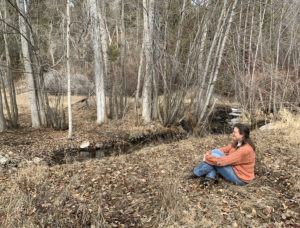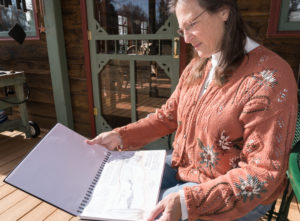
By Marnie Craig
A faint melody of pentatonic chimes sounded in the distance and dried leaves and grasses crunched underfoot as Deborah Goslin took regardful steps toward her sit-spot along the bank of Middle Burnt Fork Creek. She connects with nature on five acres east of Stevensville that host a spring fed meadow, mixed conifers and mini-forests of aspen and cottonwood. Connecting deeply to one place in nature is part of a six-month practicum to become a certified forest therapy guide, someone who guides people into nature for increased health and wellness.
She visits her sit-spot several times a week and sees the creek change every day. When she thinks it’s going to stay frozen over for a while, water starts flowing over the ice again. “I have come to think of the creek as a being even though it is made up of many different things,” she said. “It’s not just water, it has a personality. It’s surprising the connections you can make with a place when you visit it often.”
Goslin grew up exploring the rural farmlands and forests of the Adirondack Mountains in northern New York. As she played, she discovered there was more to nature than met the eye. She talked to plants and to the trees as she climbed them. In high school, she read, “The Secret Life of Plants,” by Peter Tompkins and Christopher Bird, a book that recounted experiments revealing plants were sentient beings. “I knew it,” she said. “That confirmed it for me.”
After earning a degree in Ecology and Environmental Technology at Paul Smith’s College near Lake Placid, she moved to Montana to join her boyfriend who had landed a job with the U.S. Forest Service. Goslin went to work for the U.S. Geological Survey in St. Regis, and in 1982 the two nature lovers bought five acres east of Stevensville. Four years later they married and moved onto the property where they lived close to the earth while building a house. “We lived in a tipi next to my little forest of cottonwoods,” she said.
Goslin began volunteering and banding birds at Lee Metcalf National Wildlife Refuge. She worked at the refuge as a biological science technician for 23 seasons and simultaneously worked in the same capacity for the Bitterroot National Forest for 15 years, where she still works on the rare plant survey crew.
“I started bird-watching as a teenager but I didn’t think I could make a career out of it,” she said. “I realized I could make a career of being outside when I moved to the Bitterroot Valley and discovered the refuge.”
Not long ago, a book in the window of a local book store caught her attention. The illustrated cover showed a hand reaching upward with a finger gently touching the tip of a tree leaf. Intrigued, she bought the book. “The Biophilia Effect,” by Austrian biologist Clemens G. Arvay, is an exploration of the scientific and spiritual bond between humans and nature — Goslin discovered forest bathing.

She searched online and found the Association of Nature and Forest Therapy. Looking deeper, she learned that the ANFT offered forest therapy certification classes all over the world. She signed up and attended forest therapy training in northern California last October. “Forest therapy guiding is the next step in sharing my love of natural places,” she said.
The science behind forest therapy began in the 1980s, when Dr. Qing Li, president of Japan’s Society of Forest Medicine, performed extensive research on how spending time in nature counteracts chronic stress-related illnesses. The studies showed that humans who spend mindful time in nature experience the effects of decreased blood pressure, lower blood sugar, decreased heart rate, decreased levels of the stress hormone cortisol and increased immune function.
Amos Clifford, a psychotherapist and wilderness guide from California, heard about Dr. Li’s work and traveled to Japan to meet the doctor and learn about the Japanese practice of Shinrin-yoku, bathing in the energy of the forest. Clifford came home and founded the ANFT in 2012, creating the framework for the forest therapy being offered in America today.
Goslin’s intensive training certifies her to facilitate immersive forest bathing experiences for increased health and wellness, and to promote a deeper appreciation for nature. As a forest therapy guide, she invites participants to slow down and observe nature using all of their senses.
“We start with getting quiet, going within and becoming aware of our breathing,” she said. “We focus on our five senses as well as our imaginal sense, and our heart sense — that feeling of connection. One result of forest bathing is becoming aware of what our heart is feeling.”
She uses invitations as suggestions, such as wondering what you would notice if you sat quietly beneath a tree for 20 minutes. “Some people have never done that before,” she said. “It’s all about being mindful in the forest. Slowing down and being aware of how your steps fall on the ground, the sounds, the big and small things, using all the senses, even taste.”
Goslin said that slowing down and connecting to nature allows our parasympathetic nervous system to counterbalance the stress in our lives. “When parasympathetic activity dominates, the body performs activities like digesting, detoxifying, eliminating and building immunity,” she said. “This is where healing and regeneration occur.”
Dr. Li’s studies in Japan show that forest bathing provides another way to improve our immunity. When we are surrounded by nature we breathe in phytoncides, antimicrobial compounds emitted by plants and trees. The phytoncides activate and enhance our natural killer (NK) cell activity, the cells of our immune system that fight tumors and viruses.
This reporter recently experienced a guided forest therapy walk with Goslin. In an invitation to notice what was in motion, I watched dried grasses with ringlet curls spiraling in the breeze and ponderosa pine needles in sets of three straddling branches like children swinging on monkey bars. I saw a tiny long-legged spider hanging from a thread off a tree branch. As I drew near, it scrambled up the silk and flattened itself onto the branch. If I hadn’t stopped to follow the motion I wouldn’t have known the spider was there — like many things in the forest we rarely notice.
Even though Goslin was aware of many forest details before her forest therapy training, she feels validated by the practice. “It’s ok to sit and watch a spider or a bird, for quite some time,” she said. “It’s ok and I’m getting healthier the more I do it.”
Goslin is busy finishing the requirements for forest therapy guide certification. If you are interested in forest bathing for better health, email her at naturespeake@gmail.com.
Lou McKenzie says
Deborah, you amaze me…once again. I feel so fortunate that our paths have mingled during this life. Thank you so much for your being…hu-man. I love you.
Sandy Gates says
Deb was my almost next door neighbor on the Burnt Fork. We spent some time together and we shared our love for the natural world. I’m now living in North Carolina but the time I spent on the Burnt Fork was the best time of my life. Good on you Deb!